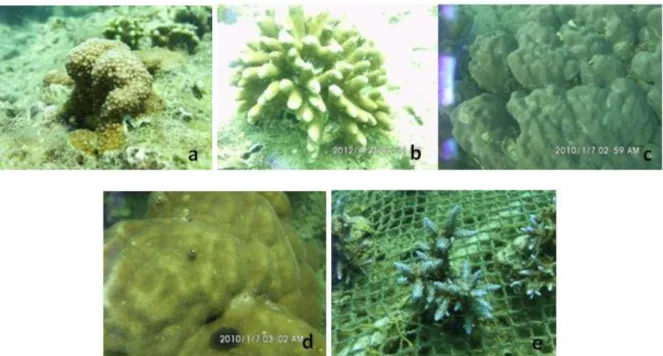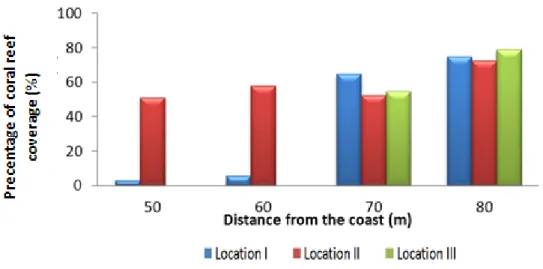VOL. 3, NO. 1, pp. 23 – 27, January, 2013
Alteration of Coral Reef Community Structure Caused by Athropogenic
Activity in the Coastal Area of Giliketapang Island, Probolinggo, East Java,
Indonesia
Lutfiatul Puspitasari, Setijono Samino, Catur Retnaningdyah*
Biology Department, Faculty of Mathematics and Natural Sciences, Brawijaya University, Malang, Indonesia
ABSTRACT
The aim of the research was to know the effect of anthropogenic activity around the coastal area of Giliketapang Island toward community structure of coral reefs. This study used belt transect method which consisted of 18 transects in three locations (harbour, near the forest, and transitionol areas) at 50-80 m from the coast, with a plot sized of 2×2m2. Abundance of coral reefs were observed based on
their coverage. There were 11 families of coral reefs found. The percentage of coral damage decreased and the number of the species increased at the zones far from the coast. This also affected the coverage value of coral reefs. Coral coverage at the harbour and near the forest was 53. 06 % and 65. 36 % respectively, whereas in the transitional area was 38. 38%. Co-domination between Porites lobata
and Chyphastrea microphthalma occurred at the harbour, while Poritesmayeri and Acropora spp. co-dominated in the location near the forest. Poritidae family co-dominated the transition area. Anthropogenic activities at transitional location caused severe damage toward coral reefs.
Keywords: coral reef, damage, Giliketapang Island
INTRODUCTION
Giliketapang island is a small island located 3.8 miles from the north of Probolinggo. Giliketapang island is formed by coral rocks, so the surrounding water is filled with a variety of reef life. The majority of people living in this island are fishermen. However, most fishermen do their activities without regard to the effects of their activities toward the environment, such as the use of some explosives causing the existence of coral reefs of no more than 40% [1]. Anthropogenic activity is not only shipping, but also waste disposal, public toilets, and coral mining. One of the real impacts to the living organisms around is the decrease in fish diversity around the coral reefs; due to the fact that coral reef ecosystem is a source of living for the organisms in its surrounding areas. Therefore, the purpose of this study was to determine the effects of anthropogenic activities toward coral reefs.
*
Corresponding author: Catur Retnaningdyah
Biology Department, Faculty of Math. and Natural Sciences, Brawijaya University, Jl. Veteran, Malang, Indonesia 65145 Email: catur@ub.ac.id
MATERIALS AND METHODS
The research used belt transect method which consisted of 18 transects in tree locations (harbour, near the forest and settlement) (Fig.1) at the distance of 50-80 meters from the coast, with a plot size of 2x2 m2. The coverage of coral
reefs for each location and station was observed using a visual technique [2]. The observation was done by diving in the depth of 3-7 meters, using aSCUBA equipment. Coral reef identification was done based on a book from Veron [3] and Suharsono [4].
The use of tree locations was based on the reason that each location has different anthropogenic activities. Location I was harbour, located in the north of Giliketapang Island, having a substrate type of sand. There was a high anthropogenic activity found in this location and it has a depth of about 4-5 m. Location I consisted of 5 transects with 10 stations for each transect. The distance between transects was 10 meters.
was not any human beings’ activities done in this location. This location consisted of 8 transects with 10 stations for each transect. The distance between transects was 5 meters.
Location III was near a settlement having a substrate type of sand with high shipping
activities since it has a depth of >5 m. This area is intermediate between settlements and homogeneous forests. This location consisted of 5 transects with 8 stations for each transect. The distance between transects was 5 meters.
Figure 1. Coverage area of study in Giliketapang Island
RESULTS AND DISCUSSION
Coral reefs found in Giliketapang island were as many as 11 families; among those families were Acroporidae, Agaciidae, Astrocoeniidae,
Faviidae, Fungiidae, Pocilloporidae, Poritidae, Siderastreidae, Oculinidae, Mussidae, and Merulinidae (Table 1).
Table 1. Diversity of coral reefs (filum: Coelenterata) in Giliketapang Island
No. Family Genus Species
1. Acroporidae Acropora Acroporaspp.
2. Mantipora M. digitata
3. M. malampaya
4. M. porites
5. Mantiporasp.
6. M. turtlensis
7. M. stellata
8. Agariciidae Coeloseris Coeloseri ssp. 9. Pavona P. decussata
10. P. frondifera
11. P. varians
12. Astrocoeniidae Stylocoeniella Stylocoeniella sp.
13. Faviidae Cyphastrea C. microphthalma
14. C. japonica
15. Favites F. abdita
16. F. complanata
17. Goniastrea G. aspera
18. G. palauensis
19. G. retiformis
20. Goniastrea sp. 1
21. Goniastrea sp. 2
22. Goniastrea sp. 3
23. Goniastreasp. 4
24. Goniastreasp. 5
No. Family Genus Species
25. Faviidae Leptrastrea Leptastreasp.
26. L. purpurea
27. Montastrea Montastreaspp. 28. Favites Favitessp.
29. Favia Faviasp.
30. Fungiidae Cycloseris C. costulata
31. Herpolitha Herpolithasp. 32. Diploastrea D. heliopora
33. Pocilloporidae Pocillopora P. damicornis
34. Poritidae Porites P. (synarea) rus
35. P. compressa
36. P. cylindrica
37. P. lobata
38. P. mayeri
39. P. nodifera
40. Poritesspp.
41. P. stephensoni
42. Alveopora Alveopora spp. 43. Ganiopora G. tenuidens
44. Siderastreidae Psammocora P. profundacella
45. Oculinidae Galaxea G. astreata
46. Galaxea sp.
47. Mussidae Lobophyllia L. flabelliformis
48. L. hemprichii
49. Merulinidae Hydnophora H. microconos
Description: A = distance from coast
(50m)
B = distance each stations (5m)
C = distance each transect (20m)
I = harbour II = near the forest III = near settlement
Location of transect
Giliketapang Island
Poritidae was a family having the largest number of species compared to the other families. Poritidae is one type of coral reefs having a massive form and sheets, especially in the Porites genus. This species has the composition of coral species coralite varying in sizes without any conesteum. Walls and septa of coralit shaped its porous. The special characteristic of septa is on its erger and each genus has a typical shape of this structure. Poritidae is a family among which having the smallest polyps [4,5]. In location I (harbour), occurred co-domination between P.lobata and
C.microphthalma, while P.mayeri and Acropora spp. co-domination was found in location II (near the forest). Acropora spp. is one type of coral reefs having a fast capability to grow and one of the
coral reefs which is extremely sensitive to environmental changes-such the changes shall happen in the environment [6]. Acropora spp. usually live in areas having frequent breaking waves, with sand and clear water. This kind of coral reef is classified as highly vulnerable to pollution, sedimentation, and fishing in the form of human activities [7]. If Acropora spp. is found in a place, then it can be said that water condition in that particular place is good and suitable for the growth of Acropora spp. coral species. Location III (settlement) was dominated with the existence of Poritidae family (Figure 2). If Poritidae family is found to be dominant in territorial water, it indicates that site is contaminated [8].
Figure 2. Dominant species of coral reef in Giliketapang Island; (a) C. microphthalma; (b) P. compressa; (c) P. lobata; (d) P. mayeri;(e) Acropora spp.
The increasing percentage of coral reefs damage caused the decrease in the number of species in each location. Coral reefs damage (bleaching) would decrease in the location far from the coast. At the distance of 70 meters from the coast, the damage began to decline which was characterized by the non-existence of coral bleaching (Figure 3a and 3b). It was caused by the decrease of the anthropogenic activities and as such the varieties of species increased. Activities causing the damage to coral reefs include waste disposal, public toilets activities, coral mining, and shipping activities. The decrease of coral reefs can occur because of disruption caused by the activities of public and environmental conditions. Interference can cause
At a distance of 80 meter from the coast, the number of coral reef species increases. It may be reasonable to assume that the farther the distance then the higher the carrying capacity of the corals reduced. However, based on (Fig. 4), the closing value at a distance of 80 meter from the coast was found to be the highest value compared to the closing value without distances. At distances of 50 and 60 m from the coast, at location III, the coral reef coverage was 0 %; in both of these distances sand dominated the environment, so there were not any coral reefs found.
The number of coral reef species will affect the percentage of coral reefs in covering each location. The more number of coral reef species, the greater the value of its coverage. The magnitude of the coverage of living and dead coral reefs was shown by the value of their coverage in each location and each transect in each location. Based on the criteria from Kreb [11], coral reefs coverage in location I and II was in good condition (53. 06 % and 65. 36), while in location III was not (38. 38 %).
Figure 3. Comparison of the percentage of coral reef damage (a) and number of coral reef species (b) based on the distance from each location in Giliketapang island (Location I= harbour; Location II= near the forest; Location III= settlement).
CONCLUSION
Anthropogenic activities especially the ones found in the settlement area can influence the community structure of coral reefs. The effect of anthropogenic activities in harbour and near the forest were less damaging than the ones in the settlement area. Activities causing damage to coral reef include waste disposal activities, public toilets activities, coral mining activities, and shipping activities. Coral reefs coverage in location I and II was in good condition (53.06 % and 65.36), while in location III was not (38.38 %). Co-domination between P. lobata
and C. microphthalma occurred in location I, P. mayeri and Acropora spp. co-domination was found in location I, and the existence of Poritidae family dominated location III.
ACKNOWLEDGMENTS
Thanks to Drs.Setijono S., M. S. DSc., and Dr.Catur R., M. Si who have helped improving this manuscript.
REFERENCES
1. Dinas Perikanan dan Kelautan (2010) Profil
Pulau Giliketapang Kabupaten Probolinggo,
Pemerintah Kabupaten Probolinggo,
Probolinggo.
2. Hill J, Clive W (2004) Methods for ecological monitoring of coral reefs. Australian Institute of Marine Science Press. Australia.
3. Veron, J. E. N (2000) Coral of The World, Australian Institute of Marine Science, Australia.
4. Suharsono (2010) Jenis-jenis terumbu karang di
Indonesia. LIPI Press. Jakarta.
5. Calfo AR (2002) Book of coral propagation: A
concise guide to the successful care and culture of coral reef invertebrates (Vol. 1). PA: Reading Trees Monroeville. Pennsylvania.
6. Sya’arani L (1992) Bentuk rangka dan
pertumbuhanAcropora aspera (Dana) di Laut
Jawa pada musim barat. Bunga Rampai Pola
Ilmiah Pokok. Universitas Diponegoro.
Purwokerto.
7. Mukhlis (2010) Ekosistem terumbu karang di
kawasan wisata bahari Gili Trawangan, Lombok dan pengaruh hidrokarbon pada masa lethal
karang Acropora spp.. Doctoral Thesis.
Universitas Negeri Malang Program
Pascasarjana. Malang.
8. Soong K, Chen CA, Chang JC (2000) The very
large poritide colony at Green Island, Taiwan. Coral Reefs. 19: 42.
9. Krishnamoorthi A, Selvakumar S (2012)
Seasonal fluctuation of zooplankton
community in relation to certain physico-chemical parameters of Veeranam Lake in Cuddalore District, Tamil Nadu. International Journal of Research in Environmental Science and Technology. 2 (2): 22-26.
10. Leksono AS (2007) Ekologi Pendekatan
Deskriptif dan Kuantitatif. Bayu Media Publishing. Malang.
11. Krebs CJ (1978) Ecology the Experimental


